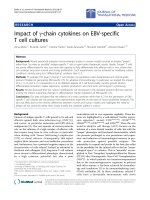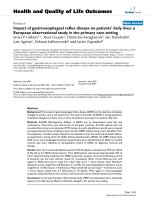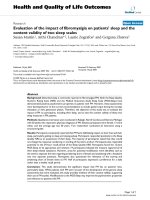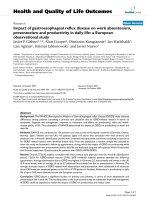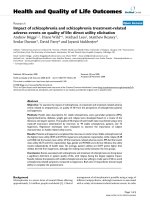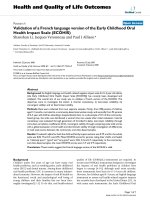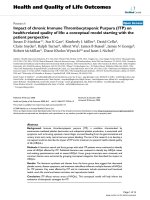Báo cáo hóa học: " Impact of the Gaussian Approximation on the Performance of the Probabilistic Data Association MIMO Decoder" pot
Bạn đang xem bản rút gọn của tài liệu. Xem và tải ngay bản đầy đủ của tài liệu tại đây (756.14 KB, 5 trang )
EURASIP Journal on Wireless Communications and Networking 2005:5, 796–800
c
2005 Justus Ch. Fricke et al.
Impact of the Gaussian Approximation
on the Performance of the Probabilistic
Data Association MIMO Decoder
Justus Ch. Fricke
Information and Coding Theory Lab, Faculty of Engineering, University of Kiel, Kaiserstraße 2, 24143 Kiel, Germany
Email:
Magnus Sandell
Toshiba Research Europe Ltd., Telecommunications Research Laboratory, 32 Queen Square, Bristol BS1 4ND, UK
Email:
Jan Mietzner
Information and Coding Theory Lab, Faculty of Engineering, University of Kiel, Kaiserstraße 2, 24143 Kiel, Germany
Email:
Peter A. Hoeher
Information and Coding Theory Lab, Faculty of Engineering, University of Kiel, Kaiserstraße 2, 24143 Kiel, Germany
Email:
Received 1 March 2005; Revised 24 July 2005; Recommended for Publication by Michael Gastpar
The probabilistic data association (PDA) decoder is investigated for use in coded multiple-input multiple-output (MIMO) systems
and its strengths and weaknesses are determined. The conventional PDA decoder includes two approximations. The received
symbols are assumed to be statistically independent and a Gaussian approximation is applied for the interference and noise term.
We provide an analytical formula for the exact probability density function (PDF) of the interference and noise term, which
is used to discuss the impact of the Gaussian approximation in the presence of a soft-input soft-output channel decoder. The
results obtained resemble those obtained for the well-known PDA multiuser detector in coded CDMA systems for which similar
investigations have been done before.
Keywords and phrases: probabilistic data association, MIMO systems, stochastic approximation, iterative methods, interference.
1. INTRODUCTION AND BACKGROUND
Probabilistic data association (PDA) has originally been de-
veloped for target t racking by Yaakov Bar-Shalom in the
1970s. Since then, it has been applied in many different ar-
eas, including digital communications. In the area of digi-
tal communications, the PDA algorithm is a reduced com-
plexity alternative to the a posteriori probability (APP) de-
coder/detector/equalizer. Near-optimal results were demon-
strated for a PDA-based multiuser decoder (MUD) for code
division multiple access (CDMA) systems [1, 2]. Recently,
This is an open access article distributed under the Creative Commons
Attribution License, which permits unrestricted use, distribution, and
reproduction in any medium, provided the original work is properly cited.
probabilistic data association has been shown to achieve
good results in multiple-input multiple-output (MIMO) sys-
tems [3, 4]. In [5], a PDA was presented for turbo equaliza-
tion of a single antenna system. It should also be noted that
the Gaussian assumption made in the PDA decoder is used in
several other MUD detection schemes, especially when ap-
plying iterative detection and decoding schemes, for exam-
ple, [6, 7, 8]. In [9], it was shown that the performance of a
coded CDMA system with PDA decoder degrades if the num-
ber of users is not large enough.
In this paper, results for a PDA MIMO decoder in com-
bination with a s oft-input soft-output channel decoder are
presented, where both decoders are not forming an itera-
tive detection and decoding scheme (see Figure 1). This is
done in order to demonstrate the impact of the unreliable
Impact of the Gaussian Approximation Made in the PDA MIMO Decoder 797
Channel
encoder
Rate
matcher
Inter-
leaver
Space-time
encoder
Rate
dematcher
Channel
PDA MIMO
decoder
Deinter-
leaver
Channel
decoder
bc π(c
r
) x
r
π(L(c)
r
)L(c)
b
Figure 1: Communication system investigated throughout this paper.
soft outputs which is far less obvious when using an iterative
decoding scheme. Because the PDA decoder inherently pro-
vides estimates of the a posteriori probabilities of the trans-
mitted data symbols, it seems to be well suited for the use in
conjunction with a soft-input channel decoder. However, the
results presented in the following show that the PDA MIMO
decoder does not always work as well as expected. We provide
an exact formula for the probability density function (PDF)
of the interference and noise term to calculate the exact sym-
bol probabilities for the symbol-by-symbol detection done in
the PDA. Simulations based on these probabilities show that
the Gaussian approximation made in the PDA decoder has
a large impact on the quality of the soft outputs provided to
the channel decoder, and therefore on the channel decoding
itself. It can be concluded that the quality of the Gaussian ap-
proximation, and therefore of the soft outputs, depends on
the number of transmit antennas and on the cardinality of
the symbol alphabet. To our best knowledge, such an analy-
sis of the PDA MIMO decoder has not been presented before.
The remainder of this paper is organized as follows.
We first introduce the system model under investigation in
Section 2.InSection 3, a PDA decoder for use in a coded
MIMO system is presented, followed by an analysis of the
Gaussian approximation and its impact on the decoding
process. A confirmation of the analytical results in form of
simulations is given in Section 4. Conclusions are drawn in
Section 5.
2. SYSTEM MODEL
Consider a MIMO system with M transmit and N receive
antennas. Like in V-BLAST [10], a single data stream is mul-
tiplexed into M parallel data streams and then mapped onto
complex modulation symbols. The M symbols are transmit-
ted simultaneously by the corresponding antennas. Before
the multiplexing is done, the data stream is encoded by a
channel encoder and interleaved by a channel interleaver.
Assuming flat fading, the equivalent discrete-time channel
model can be written in complex baseband notation as
r = Hx + v,(1)
where baud-rate sampling is assumed. The channel matrix
H ∈ C
N×M
is assumed to be constant during one data block
(block fading assumption) and perfectly known at the re-
ceiver. The channel matrix coefficients h
n,m
represent the gain
between transmit antenna m (1 ≤ m ≤ M) and receive an-
tenna n (1 ≤ n ≤ N). The vector x ∈ Q
M×1
consists of
the complex-valued transmitted modulation symbols taken
from a symbol alphabet Q with cardinality Q, while the vec-
tor r ∈ C
N×1
contains the received samples. Additive noise is
given by v ∈ C
N×1
, with complex elements that are indepen-
dent and identically distributed white Gaussian noise sam-
ples with zero mean and variance σ
2
v
= E{|v
n
|
2
}. At the re-
ceiver, the demultiplexing, or MIMO decoding, operation is
performed by the PDA followed by a deinterleaver and a soft-
input channel decoder. An overview of the system is given in
Figure 1. Please note that no turbo equalization as in [4, 5]
or feedback from the channel decoder to the PDA as in [11]
is used.
3. PDA DECODER
3.1. Basic algorithm
The conventional PDA decoder
1
uses two approximations.
Firstly, the PDA decoder looks only at one transmitted sym-
bol at a time, treating the received symbols as statistically in-
dependent. A second approximation is the Gaussian approx-
imation (“Gaussian forcing”) of the PDF of the interference
and noise. The PDA decoder approximates a posteriori prob-
abilities Pr(x
m
| r)foreveryelementx
m
of x. All symbols in-
terfering with x
m
and the noise are modeled as a single vector
w =
k=m
x
k
h
k
+ v,(2)
where h
k
denotes the kth column of H,andx
k
the kth ele-
ment of x. The interference and noise term in (2)isassumed
to be an n-variate Gaussian distributed random variable with
mean
µ
w
= E
k=m
x
k
h
k
+ v
=
k=m
E
x
k
h
k
,(3)
1
The conventional PDA decoder uses the non-decoupled system model
(which means that the received signal r is not multiplied with the inverse of
the channel matrix H
−1
). Because we are interested in a fundamental prop-
erty of the PDA decoder rather than complexity reduction, no complexity
reduction techniques as proposed in [1] are applied. Hence, the PDA de-
coder presented here suffers from higher complexity, but achieves nearly the
same performance and gives most of the equations a more comprehensive
look.
798 EURASIP Journal on Wireless Communications and Networking
and covariance
R
ww
= E
w − µ
w
w − µ
w
H
=
k=m
Var
x
k
h
k
h
H
k
+ σ
2
v
I.
(4)
If no aprioriinformation is available, the PDA decoder ini-
tializes the symbol probabilities as a uniform distribution.
Assuming the Gaussian distribution of the noise and inter-
ference term, the a posteriori probabilities for the possible
symbols x
m
can be computed using (3)and(4):
Pr
x
m
| r
=
p
r | x
m
Pr
x
m
p(r)
= c exp
−
r − x
m
h
m
− µ
w
H
R
−1
ww
r − x
m
h
m
− µ
w
.
(5)
For an estimate of the symbol x
m
, no information on sym-
bols x
k
, k ≥ m, is available. In order to provide information
on these symbols, the PDA decoder may use multiple iter-
ations, in each iteration using the symbol probabilities ob-
tained by the previous iteration. As in [1], the mean (3)and
the variance (4) are updated for every symbol probability es-
timate, incorporating the new information gained from sym-
bol probabilities already computed in the current or previous
iterations. Given the PDF in (5), log-likelihood ratios (LLRs)
can be computed to serve as soft-input for the channel de-
coder after the last iteration of the PDA decoder:
L
c
κ
= log
x
m
∈Q
+
Pr
x
m
| r
x
m
∈Q
−
Pr
x
m
| r
,(6)
where
Q
+
:={x
m
: c
κ
= bit
κ
(x
m
) = +1},(7)
Q
−
:={x
m
: c
κ
= bit
κ
(x
m
) =−1}. (8)
3.2. Actual PDF of interference and noise term
The actual PDF of the interference and noise term is a sum
of Q
M−1
Gaussian distributions, each of them caused by one
possible interfering symbol constellation as a convolution of
the discrete symbol probabilities and the PDF of the Gaus-
sian noise vector v.LetX
s
be the set of all possible symbol
vector combinations causing interference for a fixed x
m
.It
can be easily show n that the actual PDF of the interference
and noise term is
p
W
w(v)
=
x∈X
s
Pr(x)
1
πσ
2
v
N
exp
−
v −
k=m
x
k
h
k
2
σ
2
v
.
(9)
The PDF in (9) is a summation of Q
M−1
=|X
s
| single Gaus-
sian distributions with means depending on the channel as
well as the interfering modulation symbols. It is not the PDF
used for optimal (APP) detection; being the exact PDF of the
interference for one of the detected symbols, it is not employ-
ing the Gaussian approximation but still treating the symbols
−10 −5 0 5 101520253035
E
b
/N
0
(dB)
10
−6
10
−5
10
−4
10
−3
10
−2
10
−1
10
0
Coded BER
2 × 2PDAit.1
2 × 2PDAit.2
2 × 2PDAit.3
2 × 2 APP
4 × 4PDAit.1
4 × 4PDAit.2
4 × 4PDAit.3
4 × 4 APP
8 × 8PDAit.1
8 × 8PDAit.2
8 × 8PDAit.3
8 × 8 APP
Figure 2: BER performance of a turbo-coded M×N MIMO system
with PDA decoder. As a benchmark, the BER performance for an
APPdecoderisshownaswell.
as statistically independent. A derivation for the CDMA case
can be found in [12, Chapter 3.1] and was also published in
[6].
According to the central limit theorem, the quality of the
Gaussian approximation used in the PDA decoder improves
by increasing the number of transmit antennas. On the other
hand, the approximation becomes worse when modulation
schemes with more constellation points are used. With an
increasing number of constellation points, a soft bit accord-
ing to (6) is calculated by a larger number of (approximated)
probabilities, and is therefore more likely to be unreliable. It
should also be noted that the approximation is better in the
presence of strong noise. As can be seen in (9), the variance
of the single Gaussian distribution is larger for a larger σ
2
v
,
which makes the sum more likely to be Gaussian-like.
3.3. Consequences for soft-input channel decoder
Soft-input channel decoders use reliability information on
the input in form of LLRs. The reliability of the LLRs is essen-
tial for channel decoding; unreliable soft inputs cause wrong
estimates of the information bits. The LLRs delivered by the
PDA decoder are calculated from the symbol probabilities
which are based on the approximated PDF of the interfer-
ence and noise term. As shown above, the Gaussian approxi-
mation, and therefore the soft inputs of the channel decoder,
can be quite poor and thus inhibits the channel decoder from
achieving good performance. Similar results were obtained
for a coded CDMA system in [9].
4. NUMERICAL RESULTS
In order to illustrate the influence of the Gaussian assump-
tion on the performance of the PDA decoder, an M × N
Impact of the Gaussian Approximation Made in the PDA MIMO Decoder 799
0 5 10 15 20 25 30 35
E
b
/N
0
(dB)
10
−6
10
−5
10
−4
10
−3
10
−2
10
−1
10
0
Coded BER
PDA with actual PDA it. 1
PDA with actual PDA it. 2
PDA with actual PDA it. 3
PDA it. 1
PDA it. 2
PDA it. 3
APP
Figure 3: BER performance of a turbo-coded 2 × 2MIMOsystem
with conventional PDA decoder and PDA decoder using the actual
PDF of the interference and noise term. As a benchmark, the BER
performance for an APP decoder is shown as well.
MIMO system in conjunction with a turbo code has been
investigated. As a benchmark, the BER performance for an
APP decoder has been simulated as well. A block length of
2304 information bits is used. The bit energy to noise ratio
is defined as E
b
/N
0
= σ
2
x
σ
2
h
/qRσ
2
v
,withq being the number
of bits per modulation symbol and R denoting the code rate.
The average power per symbol constellation point is denoted
by σ
2
x
. The elements h
n,m
of H are statistically independent
random variables (each component being complex Gaussian
distributed with zero mean and variance σ
2
h
= E{|h
n,m
|
2
}). A
rate 1/2 turbo code with polynomials (5,7) and 4 iterations in
the turbo decoder is applied. The rate matcher ensures that
the coded block length is a multiple of qM, and therefore can
be multiplexed to the M transmit antennas.
The number of iterations given in Figures 2 and 3 are
the iterations done in the PDA algorithm before the soft esti-
mates of the bits are given to the channel decoder. While the
PDA achieves good results when using no channel code [3],
the results of the coded system can be far from the optimum.
In Figure 2, it can be seen that the difference between the APP
and the PDA decoder is the largest for the 2 × 2systemand
improves with an increasing number of antennas. Especially
for the 2 × 2 system, the gap between the APP and the PDA
decoder is getting larger with an increase in E
b
/N
0
. Further-
more, the third iteration is not, as it should be, the best one.
This is explained by the quality of the soft-output generated
by the PDA decoder, which degrades with every iteration as
(unreliable) probabilities computed by the previous iteration
are used.
To demonstrate the impact of the Gaussian approxi-
mation on the performance of the coded PDA system, in
Figure 3, the results for the 2 × 2 system are shown for the
PDA decoder using the Gaussian approximation compared
to the decoder using the actual PDF of the interference and
noise. It is clearly seen that the problems arise from the Gaus-
sian approximation made in the PDA, as the PDA decoder
using the nonapproximated PDF a chie ves near-optimal re-
sults. We have found similar results for convolutional codes
and different code rates.
5. CONCLUSION
The impact of the Gaussian approximation in the conven-
tional PDA MIMO decoder on the performance of a MIMO
system using a soft-input channel decoder was shown. It was
shown that the Gaussian approximation is the best for a large
number of transmitting antennas and a small number of
constellation points in the modulation scheme. Its influence
on the quality of the soft outputs, and therefore the chan-
nel decoder has been investigated. Furthermore, it has been
illustrated that the main degradation of the performance of
the PDA decoder is the Gaussian approximation and not the
symbol-by-symbol decoding. The results of this pap er hold,
in principle, also for a multiuser detection scenario where the
usually large number of interferers results in a good approx-
imation. The PDA decoder was applied in iterative decoding
schemes for CDMA [2] and MIMO [11] systems. In itera-
tive schemes, the PDA decoder may achieve a performance
close to optimum. A formula for the actual PDF of inter-
ference and noise for CDMA MUD can be found in [12]. A
way to improve the performance when using the PDA MIMO
decoder with a soft input channel decoder might be impor-
tance sampling as proposed in [11] or the combination with
sphere decoding [13].
REFERENCES
[1]J.Luo,K.R.Pattipati,P.K.Willet,andF.Hasegawa,“Near-
optimal multiuser detection in synchronous CDMA using
probabilistic data association,” IEEE Commun. Lett., vol. 5,
no. 9, pp. 361–363, 2001.
[2] P.H.Tan,L.K.Rasmussen,andJ.Luo,“Iterativemultiuserde-
coding based on probabilistic data association,” in Proc. IEEE
International Symposium on Information Theory (ISIT ’03),
pp. 301–301, Yokohama, Japan, June–July 2003.
[3] D. Pham, K. R. Pattipati, P. K. Willet, and J. Luo, “A gener-
alized probabilistic data association detector for multiple an-
tenna systems,” IEEE Commun. Lett., vol. 8, no. 4, pp. 205–
207, 2004.
[4] S. Liu and Z. Tian, “Near-optimum soft decision equalization
for frequency selective MIMO channels,” IEEE Trans. Signal
Processing, vol. 52, no. 3, pp. 721–733, 2004.
[5] Y. Yin, Y. Huang, and J. Zhang, “Turbo equalization using
probabilistic data association,” in Proc. IEEE Global Telecom-
munications Conference (GLOBECOM ’04), vol. 4, pp. 2535–
2539, Dallas, Tex, USA, November–December 2004.
[6] J. F. R
¨
oßler and J. B. Huber, “Matched filter for transmission
over channels with ISI employing the distribution of inter-
ference,” in Proc. 57th IEEE Semiannual Vehicular Technology
Conference (VTC ’03), vol. 4, pp. 2648–2652, Jeju, South Ko-
rea, April 2003.
800 EURASIP Journal on Wireless Communications and Networking
[7] W. K. Leung, L. Liu, and L. Ping, “Interleaving-based mul-
tiple access and iterative chip-by-chip multiuser detection,”
IEICE Transactions on Communications, vol. E86-B, no. 12, pp.
3634–3637, 2003.
[8] F. Br
¨
annstr
¨
om, T. M. Aulin, and L. K. Rasmussen, “Iterative
detectors for trellis-code multiple-access,” IEEE Trans. Com-
mun., vol. 50, no. 9, pp. 1478–1485, 2002.
[9] P.H.TanandL.K.Rasmussen,“Multiuserdetectionbasedon
Gaussian approximation,” in Proc. IEEE 3rd Workshop on The
Internet, Telecommunications and Signal Processing (WITSP
’04), pp. 231–236, Adelaide, Australia, December 2004.
[10] G. D. Golden, C. J. Foschini, R. A. Valenzuela, and P. W.
Wolniansky, “Detection algorithm and initial laboratory re-
sults using V-BLAST space-time communication architec-
ture,” Electronics Letters, vol. 35, no. 1, pp. 14–16, 1999.
[11] Y. Jia, C. Andrieu, R. J. Piechocki, and M. Sandell, “Improv-
ing soft output quality of MIMO demodulation algorithm via
importance sampling,” in Proc. IEE 5th International Confer-
ence on 3G Mobile Communication Technologies (3G ’04),pp.
387–390, London, UK, October 2004.
[12] J. F. R
¨
oßler, Equalization for PAM- and DS-CDMA-based
transmission systems, Ph.D. dissertation, Friedrich-Alexander
University of Erlangen-N
¨
urnberg, Bayern, Germany, Januar y
2005.
[13] Y. Jia, C. Andrieu, R. J. Piechocki, and M. Sandell, “Gaus-
sian approximation based mixture reduction for near opti-
mum detection in MIMO systems,” to appear in IEEE Com-
mun. Lett
Justus Ch. Fricke studied electrical en-
gineering, information engineering, and
business administration at the Christian-
Albrechts-University of Kiel, Germany, with
a focus on digital communications. Dur-
ing his studies, he spent six months with
the Toshiba Telecommunications Research
Laboratory in Bristol, UK. He received
the Dipl Ing. degree from the Chris-
tian-Albrechts-University, in 2004. Since
September 2004, he is working towards his Ph.D. degree as a Re-
search and Teaching Assistant at the Information and Coding The-
or y Lab (ICT) at the University of Kiel. His research interests con-
cern multiple-access techniques for next-generation wireless sys-
tems, especially interleave-division multiple-access (IDMA), and
cross-layer design.
Magnus Sandell received an M.S. degree in
electrical engineering and a Ph.D. degree
in signal processing from Lule
˚
a University
of Technology, Sweden, in 1990 and 1996,
respectively. He spent six months as a Re-
search Assistant with the Division of Sig-
nal Processing at the same university be-
fore joining Bell Labs, Lucent Technologies,
Swindon, UK, in 1997. In 2002, he joined
Toshiba Research Europe Ltd., Bristol, UK,
where he is working as a Chief Research Fellow. His research inter-
ests include signal processing and digital communications theory.
Currently, his focus is on multiple-antenna systems and space-time
decoding.
Jan Mietzner studied electrical eng ineering
at the Faculty of Engineering, University of
Kiel, Germany, with focus on digital com-
munications. During his studies, he spent
six months in 2000 with the Global Wire-
less Systems Research Group, Bell Labs, Lu-
cent Technologies, Swindon, England, UK.
He received the Dipl Ing. degree from the
University of Kiel in 2001. For his Diploma
thesis on space-time codes, he received the
Prof. Dr. Werner Petersen-Award. Since August 2001, he is working
toward his Ph.D. degree as a Research Assistant at the Information
and Coding Theor y Lab (ICT), University of Kiel. His research in-
terests are concerned with physical layer aspects of future wireless
communications systems, especially multiple-antenna techniques
and space-time coding.
Peter A. Hoeher received the Dipl Ing.
and Dr Ing. (Ph.D.) degrees in electri-
cal engineering from the Technical Univer-
sity of Aachen, Germany, and the Univer-
sity of Kaiserslautern, Germany, in 1986
and 1990, respectively. From October 1986
to September 1998, he was with the Ger-
man Aerospace Center (DLR), Oberpfaffen-
hofen, Germany. From December 1991 to
November 1992, he was on leave at AT&T
Bell Labs, Murray Hill, New Jersey. In October 1998, he joined
the University of Kiel, Germany, where he is currently a Pro-
fessor of electrical engineering. His research interests are in the
general area of communication theory with applications in wire-
less communications and underwater communications, includ-
ing digital modulation techniques, channel coding, iterative pro-
cessing, equalization, multiuser detection, interference cancella-
tion, and channel estimation—subjects on which he has pub-
lished more than 100 papers and filed 12 patents. He received the
Hugo-Denkmeier-Award ’90. Between 1999 and 2004, he served
as an Associate Editor for the IEEE Transactions on Communica-
tions. He is a frequent consultant for the telecommunications in-
dustry.

